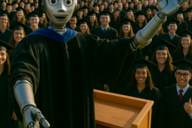You have /5 articles left.
Sign up for a free account or log in.
Of course Bill and Melinda would want my take on saving the world. I am the nation’s most prestigious obscure columnist on the deadening topic -- on the American Idol/Lost Applause Meter -- of community colleges.
In fact, I skipped the meeting. Out of respect for Bill and Melinda. Their schedule and to-do list, running the largest foundation in the world, has to be beyond what even the latest version of Microsoft Outlook and a server farm the size of Nebraska could ever handle.
To save time, I’ll pick up where the meeting was sure to end anyway. Melinda nodding to Bill, who turns to me and says, “OK. You have a blank check. What will you do? You have four minutes.”
No one has done better than Gates with a plan for “The Problem Too Big To Be Seen,” the crisis of the work force and community colleges, than the February 2008 Gates Foundation paper "Post-Secondary Education+: An initiative to dramatically expand social mobility in America." A friend at Gates sent (not leaked) the paper to me a few of weeks ago. The paper, at Gates’s now-familiar New Deal scale and ambition, offers two key conclusions.
“First, our research revealed that a high-leverage intervention point in breaking the intergenerational transmission of poverty is to focus on young people in the critical decade between ages 16 and 26, as they make the transition to adulthood and as (or before) they become parents themselves. Second, our research showed that if one were to choose the single most important lever for improving the life prospects of these young people and their children, it would be to help young adults earn educational credentials beyond a high school diploma.”
Right on, Bill and Melinda.
Recognizing the enormity of the task, the paper sets a 20-year timeline for the initiative. “By the year 2027, we aim to double the percentage of low-income young people who earn a post-secondary credential by the age of 26 (from 30 percent to 60 percent).” Agree. Disagree. The issue is not the $38 billion backing Gates. This is the only national plan on the table at all. Now, to my reply.
*****
August 2, 2008
Memorandum to: Bill & Melinda Gates
From: Wick Sloane, wsloane@well.com
Subject: Post-Secondary+ Project, Next Steps
You asked for a succinct plan on what I would do to advance this project if given a blank check. The February 5, 2008 paper captures well the immense opportunity. The challenge now is to take the insights of that paper and begin at a scale that both reflects the gravity and the urgency of the problem and leverages the considerable resources that the Gates Foundation can invest in the solutions.
Education too often overlooks the production and operations-research dimensions of the problem. Affecting the 4.2 million students pursuing a postsecondary education and 5.4 million low-education workers, even to give each a toothbrush and a dictionary, is a production problem of humbling complexity. Delivering an intangible called “education” is more challenging.
Whether the population, though, is a tutorial of one student, or an Immediate-Priority Target Population (IPTP) of 9.6 million, Post Secondary+ must not lose sight of the basic questions for any educational undertaking: Who is the audience? What do you want them to learn by when? Where are they? How many students? In terms of seats, classrooms, and appropriate faculty versus what is available now, what is the math of “doubling the percentage of low-income young people who earn a post-secondary credential by the age of 26” by 2027? This is the starting framework of my reply. While these are not the only ways to go, this is an example of how I tackle such problems.
(1) Identify key locations and concentrations of the IPTP, and then identify the community colleges with strong leadership serving those locations. If any geographic locations have high concentrations of the IPTP and strong community colleges, that’s a good place to start. If not, pick 10 campuses with strong leadership in major cities such as Boston, New York, Chicago, Dallas and Los Angeles. Aim for the potential to affect at least 100,000 students quickly.
(2) Ask my colleagues, Art Swersey at Yale School of Management, Karim Lakhani at Harvard Business School and Steve Gardner of the New York advertising firm Gardner-Nelson, what they would need to do a credible survey of the IPTP in these locations. My first objective is to understand the daily lives of this population and to determine their current TAL – Time Available for Learning. Given their jobs and commutes and family responsibilities, what TAL is really available? And what skills does the IPTP need? What health care and social services for the IPTP will Post-Secondary+ success require?
Wick Sloane’s Previous
Community College Columns
'Running Scared in the Schoolyard,' July 11
Where Graduates are Grandmothers, June 5
Day in the Life, April 18
Example: A current student of mine is a Lost Boy from Sudan. He works two shifts a day at Logan, seven days a week, to pay rent and for a lawyer to bring his wife and son to the U.S. He has been taking regular courses for two years, but still has gaps in reading and writing. I put on the brakes. In truth, Simon has only Monday and Wednesday mornings available (his TAL). We assessed his reading and writing and what exactly he needs to stop spinning his wheels. He now has a program for just that, using the many excellent tools including technology in the language lab. Two weeks ago, this began. He has been in each day. We decided, with him, that any additional assignments are unrealistic. He has no opportunity to sit at a computer to write. He does have long commutes and breaks at work. I bought him a marble notebook and two packs of decent pens. When Simon can, he writes stories about Sudan. We will keep at this until he is ready to return to the regular track. Many community colleges do just this, without charging the student. Last week, Simon brought me 54 pages he had written in that marble notebook. His pride was a once-in-a-career teaching moment.
This illustrates a key question for Post-Secondary+: What are the tradeoffs between investing in pedagogies effective for the scarce TAL of the target population versus simply funding the lost income for these students to be able to attend traditional courses full time? Remember, going to school part time is a leading indicator of likely failure. Lost income rather than only tuition scholarships is a substantial obstacle for the IPTP.
(3) Ask this team, or another, how to assess the delivery capacity of the community colleges in these areas in the high need subjects for the IPTP. First, just in terms of available seats. Community colleges already operate day and swing shifts, with waiting lists. The Post-Secondary+ analysis presumes that more students will be taking more courses. What subjects? What about faculty? Can the current systems handle even half the 5.4 million Low-Education Workers?
(4) Develop a realistic assessment of how to complete Steps 1-4 in a useful, credible way. The data even to begin Steps 1-4, above, may not exist. I can’t find anyone who has asked these questions for a city or a state, let alone the nation. This is just the kind of question that the Gates Foundation has the resources – intellectual and financial-- to ask. A timeline for 1-4 depends on a realistic project plan and, more important, sufficient qualified people to do the work.
(5) As a parallel project, Post-Secondary+ must assess the public dialogue necessary for success. As an ally, an opponent, or a partner, how will public institutions affect the outcome of the project? What is the public awareness of the Post-Secondary+ problem now? How could public opinion help or hinder Post-Secondary+? Community colleges exist within the current democratic process and often complex local politics. I don’t know Daniel Yankelovich personally. His book Coming to Public Judgment, Making Democracy Work in a Complex World (Syracuse University Press, 1991) raises key issues for Post-Secondary+. I would invite him, or people of similar expertise, to assess the public and democratic dialogue that must accompany Post-Secondary+.
The work of the Post-Secondary+ project is essential. Your boldness is as important as your generosity.




